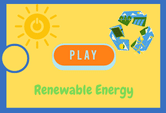Renewable Energy Game Quiz Online
This page features a Renewable Energy Game Quiz Online. It is an exercise for students studying science in 3rd, 4th, 5th, 6th to 8th grades. Students will learn about renewable energy and its sources. Remember to learn more by readding the article below.

Sources of Renewable Energy
Renewable energy is energy produced from sources like the sun and wind that are naturally replenished and do not run out. Renewable energy can be used for electricity generation, space and water heating and cooling, and transportation. There are many different sources of renewable energy. We'll briefly touch on Wind, Solar, Water, and Biomass. Which of these sources is best for you? And why? Read on to discover the benefits of each. Renewable energy is becoming more popular as a way to meet our energy needs.
Wind
The wind is a great source of renewable energy, reducing our dependency on polluting fossil fuels. Wind energy is created by using wind turbines, which convert the wind's kinetic energy into mechanical power. Once that mechanical energy is converted to electricity, it can be used for specific tasks.
Wind as a renewable energy source has a long history, dating back to ancient Egypt and Greece. The Egyptians invented waterwheels and windmills for irrigation and cutting wood. Don Quixote sought to create windmills in Spain. Dutch engineers displayed four-bladed windmills on postcards, while U.S. engineers took wind power to new heights. But the technology has come a long way.
Solar
Solar energy is another form of renewable energy which is abundance in tropical regions. It requires the use of solar panels to capture sunlight and convert it to energy which can be stored in batteries and used to power homes. It is also becoming a popular source of energy since it is clean. However, creating large wind farms to capture it and as well as storage are still a major issue.
Water
Water is another sources and never runs dry since it is recycled through the water cycle. Waves and hydro electric power plants are a great source of renewable energy. Hydro electriciy is one of the most popular sources of electric power world wide.
Biomass
Researchers are now using novel chemical, physical, and biological routes to produce renewable bioenergy. Estimates of crop biomass availability in India are as high as 500 million metric tons per year, with the potential to generate energy equivalent to 18,000 megawatts. Such numbers point to a promising future for the country's energy production. The potential for biomass energy is immense. Moreover, the country's current infrastructure supports biomass production at a high rate.
Several different types of biofuels are made from biomass, the most abundant of which is wood. The sources of biomass include forest residues such as dead trees, branches, and stumps, municipal solid waste, and yard clippings. Other biomass sources are plants such as hemp, soy residue, bamboo, and sugarcane. The resulting biofuels are suitable for both heating and transporting liquid and gas. Some renewable energy sources can be produced from any source, including wood, waste, and biomass feedstocks.
Geothermal
Geothermal renewable energy is a form of alternative energy that comes from hot springs and hot rock formations. Historically, humans have used these hot springs for bathing and heating. Monkeys have been known to use hot spring water for a variety of purposes. While geothermal energy is a renewable source of energy, it can be expensive to extract and convert into usable energy. Thankfully, geothermal technology is becoming increasingly affordable, making it feasible for individuals and companies to tap its potential.
Although there are many advantages to geothermal renewable energy, some of the biggest advantages include low initial costs and long-term fixed power prices. They also help reduce the risk of energy crises and give the us an ideal alternative source of power. Unlike fossil fuels, geothermal power plants can run around the clock, producing both electricity and heat. Its ability to operate at very high levels of availability also makes it attractive to a wide variety of businesses and households.
